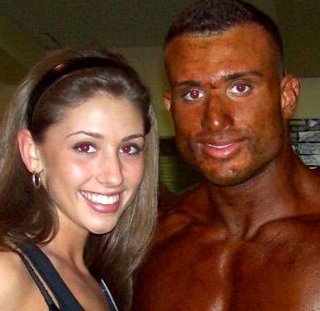Critical Essay: Orangeness as Signifier
can you write a suitable postmodern essay describing this tendency — this premature greying of the hair, this orangeing up of the skin to look as though they just stepped off the boat from Sicily, as an attempt at status seeking through the assumption of age-inappropriate power signals and intergenerational leapfrogging, with reference to the latest socio-biology theory as necessary?
Can you do that?
Thanks.
– Jacques Douchida
—-
In the 17th-19th Centuries, Western culture viewed tanned or “dark” skin along two axes of distinction. Firstly, a tan was a sign of lower class status, because it marked you as working in the fields and were therefore a day laborer. Alternately, it was a form of marking the body as Africanized, an impure non-white bloodline. With alabaster whiteness marked as a sign of aristocracy, any deviation reconfigured one’s body as “ethnic,” moving one towards the base prism of the “lower” classes; Latino, black, Italian or Asian.
These hierarchies of skin tone served to draw race and ethnic based lines of class distinction. But as society reconfigured itself in early 20th Century modernity into that of mass assembly line and large factory work, the tan transformed itself. Its signifier shifted from that of lower class “ethnic” status into that of one privileged with leisure time. The tan marked one as affluent enough to “lay about” outside, rather than work inside in the factory.
But, in today’s Vegasified land of scrotal slackdom, Orangeness functions quite differently. It operates complexly, signifying not only one who has excessive leisure time to tan, but also the financial means to tan “artificially.” Thirdly, it’s very artificiality marks one’s body as mechanized and commodified. And fourthly, it echoes suburban co-option of African-American “authenticity,” also seen in the imitation of “gangsta” tropes.
In other words, Orangeness marks itself simultaneously as natural process and as unnatural artificial echo, while also “Africanizing” the body as oppositional, and therefore rebellious. Orangeness becomes the “alabaster white” skin of earlier historical periods, in its configuration as a denial of natural “working class” status, and in its affirmation of the freedom to mark one’s body through conscious choice (similar to the tattoo).
It is here, within this paradoxical signifier of both the natural and the artificial, that Orangeness marks its difference complexly. Or “differance,” as the case may be. Orangeness is never meant to be seen as natural skin tanning. Its cultural potency lies in the fact that it is a performance of naturalism by way of product. It is a ritualistic re-encoding of the natural as kabuki for the purposes of theatrical inscription. The Orangeman finds the authentic by simulating the real.
One does not orangify to state that one lies in the sun. One orangifies to state that one purchases the products of leisure-inspired mimicry without natural process.
In this understanding, turning one’s self orange is distinctly postmodern. For it articulates its meaning simultaneously as industrial product, commodity and class system. Yet in an unstable and shifting framework of visceral spectacle. All within a liminal structure of boobies.



